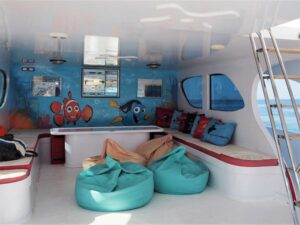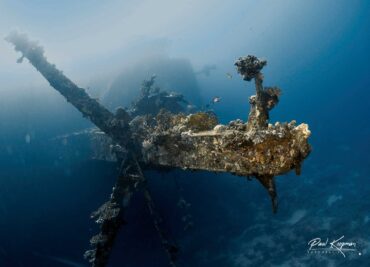Salem Express
The Salem Express, with at least 650 passengers and crew aboard, capsized on a December night in 1991. Hundreds drowned, the wreck in the Red Sea is an obscure, popular dive site.
The Salem Express
The Salem Express, with at least 650 passengers and crew aboard, capsized on a December night in 1991.
Hundreds drowned, the wreck in the Red Sea is an obscure, popular dive site.
The wreck of the Salem Express is a popular dive destination
REPORTER by Paul Koopman
We’ve been out for four days on the Dory, a dive charter whose lounge area is painted with a cheery scene from the Disney movie Nemo, as guide Mostafa pulls out a dive card and puts on a serious face. “This is our next dive destination,” he says, tracing the outline of a drawn wreck with his index finger. “In and around the wreck you can still find belongings of pilgrims who drowned here. The captain wanted to take a shorter route at night in heavy weather and sailed onto a coral reef. The ship was already cursed because it changed its name five times – that brings bad luck. Within twenty minutes, the Salem Express was sunk.”
Buddy Niek Fonteine and I look at each other: do we actually feel like doing this? The Salem Express is a popular but controversial dive destination because the ferry has been harboring remains since it sank in 1991. On the other hand: every wreck has its own horror story. The Red Sea is full of them: warships like the Thistlegorm, loaded with engines and jeeps, now largely overgrown by hard and soft coral. The captain on such wrecks has given way to a giant grouper or an overgrown barracuda that now calls the shots in and around the ship. A wreck dive, because of its impressive setting, unique history and the new life that has settled there, is an experience that stays with you for a long time. “Near the portholes you will find a Nemo fish in an anemone,” says Mostafa. “The sea grave is not accessible, those spaces are closed.” We are converted.
The Salem Express is over 115 meters long. It lies on its starboard side, at a depth of twelve to thirty-five meters. As we descend along the anchor chain, the dark contours of the wreck soon outline themselves: like exposed photographic paper placed in a bathtub developer. It rests on a giant mast. The hull is bathed in light and completely covered with tiny tufts of coral.
As the ship lies on its side you will find vertically in the water the bridge – some of the glass is still intact – winches, steel doors and a tangle of steel and cables. The davits, the hoists from which the lifeboats hung, are empty. One sloop lies on the seafloor; the other mysteriously disappeared a few years ago. Diving around the wreck, we see that the colossal door to the hold is open. Do we dare to go in there?
Fatal route
Saturday night, December 14, 1991, things went horribly wrong. It was storming, the waves were up to three meters high, but the atmosphere on board was festive. The deck was full of mattresses and bags of pilgrims on their way back from the hadj in Mecca. There were also many guest workers on board who worked in Saudi Arabia and carried souvenirs for their families back home. Below deck, dozens of the 71 crew members watched a popular Egyptian movie. The experienced captain Hassan Khalid Moreau was asleep in his cabin, behind the helm was first mate Mustafa Hamad Abdel Gowad. The ship had already been delayed for two days when leaving Jiddah due to a fire in the engine room, it was decided to take a shorter route along the Hyndeman reef, which saved at least two hours of sailing.
According to Gowad, the violent storm took the ship off course, ramming the Hyndeman reef. Other crew members stated in a reconstruction of the Los Angeles Times that he had made a navigational error. Either way, the consequences were catastrophic. The collision ripped open the forward cargo door of the roll-on-roll-off vessel. Panic broke out on board, the lights went out. Because the ship capsized within minutes and made water quickly, only one lifeboat managed to celebrate. Many passengers were trapped below deck like rats. The passengers who could not afford a cabin were floundering in the water in no time. Captain Moreau, startled awake by the tremendous thump, sent out a mayday. “Hello, this is the Salem Express. We were to enter the harbor at 11:30. We’re thirty kilometers offshore and we’re sinking!”
Survivors told of screams from cabins filling up, crew members rushing down to wake passengers. Floating in the sea were a few rubber rafts and lifebuoys that were being fought over. Meanwhile, the ship tilted dangerously to starboard. First mate Ahmed Khalid Mamdough stated afterwards, “It was like the Titanic. I jumped into the sea and looked over my shoulder and there was nothing left of the ship.”

Long-distance swimmer
Four people had climbed onto a floating wooden door, but were soon washed off it by the high waves. A nurse clung to an oar for hours until she saw a life raft that was full of water and contained three dead bodies. Most of the pilgrims could not swim and drowned in their white hadj clothes. But Ismail Abdel Hassan was an amateur long-distance swimmer. He swam in the swirling sea toward the harbor light. On the way, he tried to rescue two drowning men who clung to his clothing but they died of exhaustion within two hours. Ismail persisted. After eighteen hours of nonstop swimming, he climbed ashore the next day, exhausted.
The entrances to the 428 passenger quarters were welded shut
Meanwhile, an extensive rescue operation had begun in which amateur divers also participated as volunteers. Some were so impressed with what they found that they would never put on a diving mask again. Of the more than 650 passengers and crew members – some eyewitnesses say there were twice as many passengers on board – less than 180 lived to tell the tale. According to the Lloyd’s casualty report, 117 bodies were recovered, including that of Captain Moreau (45), who had not left his ship and was found on the bridge. Authorities ruled after three days that it was too dangerous to recover remaining victims from below-deck quarters. Er so the entrances to the total of 428 passenger quarters were welded shut.
Children’s bags
As we swim into the hold, shivers run down our spines. We see a radio cassette deck, children’s clothes, travel bags and cooking utensils. Bundles of mattresses and blankets. Somewhere on the other side of the thin steel must be the final resting place of hundreds of victims, we realise. At least 485 people from the official passenger list were never recovered. Unbearable for the bereaved, who still have no one to bury. I think of the recent explosion in a residential block in Rotterdam, the despair of family members who could not immediately recover their loved ones. Back aboard the dive charter, we review the photos we took and fill out our logbooks. A little over an hour we were underwater, at a maximum depth of 28 meters. The Nemo in its anemone, we found it. The stabilizers on the side of the wreck, they are sharp in the photo. A staircase that leads nowhere. A beautiful piece of coral with a pennant fish; A radio cassette recorder, covered in dust. And then, in a photo of the disorder in the ship’s hold, I see a large burlap sack with an ominous inscription. Happy Journey.


